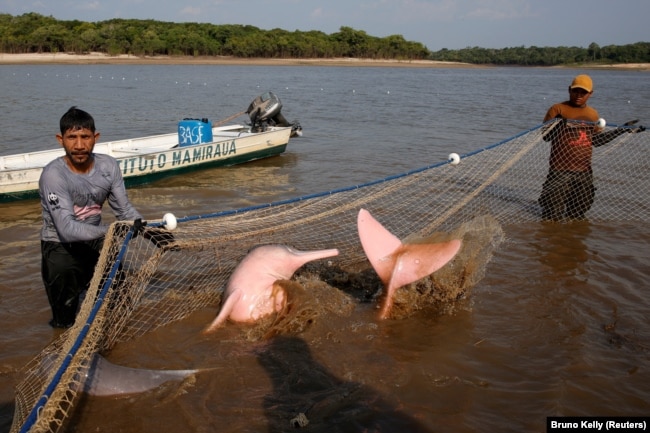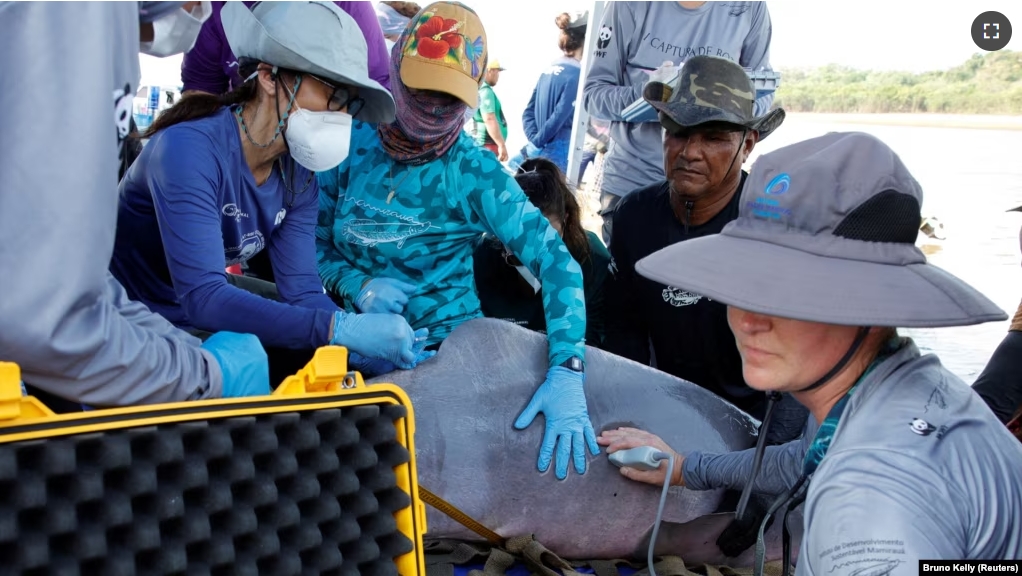About 200 freshwater dolphins were found dead in Lake Tefé of the Amazon River in Brazil during a period of severe dry weather last year.
That is why a team of biologists, animal doctors, and fishermen temporarily captured some river dolphins recently to study their health. The researchers hope the findings will help protect the dolphins from another weather disaster.
One of the captured dolphins was a female with her offspring nearby. Fishermen were careful not to injure her and kept her close to her offspring to avoid stressing the animals.
“She relaxed and we could do all the tests. She appeared in good health,” said project leader Miriam Marmontel. She is a researcher at the Mamirauá Institute of Sustainable Development based in Tefé, Brazil. The organization planned the temporary capture of up to 20 dolphins.

The team took blood from the animals and performed other medical tests. The work included removing a small amount of fat to see if harmful chemicals were in the dolphin’s body. They also put microchips in the animals to follow their movements.
The Solimões River feeds water into Lake Tefé. Unusually dry weather last year caused water levels in the river to drop. As a result, the water became warmer than usual. Thousands of fish also died in the Amazon rivers because of a lack of oxygen in the water.
Many Amazon river dolphins are the color pink. They are found only in the rivers of South America, and they are among only a few kinds of freshwater dolphins still living in the world. Because they reproduce slowly, threats to their environment can more easily reduce their populations.

Marmontel said researchers hope to better understand what caused last year’s deaths, so that experts and officials can react faster to the effects of this year’s dry weather.
“We aim to learn more about the health of the dolphins at a time when water begins to go down and temperatures start to rise, so we can identify the changes and know whether they are due to higher temperatures or a toxin or pollutant in the water,” she told Reuters.
The river dolphin research project received financial support from the National Marine Mammal Foundation of California in the United States. That organization’s researchers helped examine the dolphins using ultrasound technology.
Marmontel said most of the dolphins that died last year were in Lake Tefé. The lake is very close to the Solimões River.
The lake’s waters reached 40.9 degrees Celsius during the 2023 dry season, more than 10 degrees higher than the average for that time of year. The water is now at 30 degrees Celsius, said Ayan Fleischmann. He is a geosciences researcher at the Mamirauá Institute.
Environmental activists have blamed climate change for the severe dry weather that made the river water warmer than normal. However, El Niño, the periodic and natural Pacific Ocean warming weather event could also have brought about last year’s dry weather in the Amazon.
I’m Andrew Smith.
Bruno Kelly reported this story for Reuters. Andrew Smith adapted the report for VOA Learning English.
________________________________________________
Words in This Story
offspring -n. an animal or child as related to its parent
stress -v. to cause worry or anxiety
level -n. the height of the surface of a body of water or other substance
toxin -n. a poisonous substance produced by animals, plants, or bacteria
ultrasound -n. sound waves that are used to get images of the inside of a human or animal body
